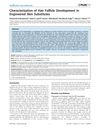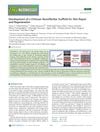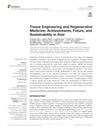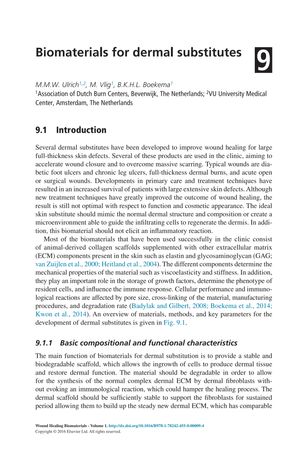TLDR The document concludes that a complete skin restoration biomaterial does not yet exist, and more clinical trials are needed to ensure these therapies are safe and effective.
The document from 2016 reviews the development of biomaterials for dermal substitutes aimed at enhancing wound healing for significant skin defects. It emphasizes the need for these substitutes to replicate normal skin structure, support cell infiltration, and avoid inflammatory reactions. Collagen scaffolds, chitosan, silk fibroin, and nonbiological polymers are discussed as materials used in these substitutes, with their properties being adjustable through various production techniques. The document also explores methods to improve mechanical strength and biocompatibility, such as cryogelation and electrospinning, and the potential of bioprinting. It highlights the importance of including skin appendages and rapid vascularization in future research to create fully functional skin substitutes. Additionally, it notes the role of the lymphatic system, the need for proper reinnervation, and the significance of hair follicles and other skin glands. The use of growth factors and stem cells to enhance regenerative capacity is mentioned, with a call for more research into recruiting endogenous stem cells. Despite progress, the document concludes that a complete skin restoration biomaterial is not yet available, and emphasizes the necessity of clinical trials to validate the efficacy and safety of these therapies.
 355 citations
,
August 2013 in “Acta Biomaterialia”
355 citations
,
August 2013 in “Acta Biomaterialia” The nanofibers with two growth factors improved wound healing by supporting structure, preventing infection, and aiding tissue growth.
 41 citations
,
June 2013 in “PLOS ONE”
41 citations
,
June 2013 in “PLOS ONE” Engineered skin substitutes can grow hair but have limitations like missing sebaceous glands and hair not breaking through the skin naturally.
 84 citations
,
June 2013 in “Stem Cells Translational Medicine”
84 citations
,
June 2013 in “Stem Cells Translational Medicine” New methods for skin and nerve regeneration can improve healing and feeling after burns.
 39 citations
,
September 2011 in “Tissue Engineering Part B-reviews”
39 citations
,
September 2011 in “Tissue Engineering Part B-reviews” Hair follicle regeneration in skin grafts may be possible using stem cells and tissue engineering.
 162 citations
,
July 2011 in “Biomacromolecules”
162 citations
,
July 2011 in “Biomacromolecules” Chitosan nanofiber scaffolds improve skin healing and are promising for wound treatment.
28 citations
,
March 2011 in “Journal of Investigative Dermatology”
 8 citations
,
May 2023 in “Gels”
8 citations
,
May 2023 in “Gels” Chitosan hydrogels are promising for repairing blood vessels but need improvements in strength and compatibility.
25 citations
,
November 2022 in “Frontiers in Bioengineering and Biotechnology” Composite biodegradable biomaterials can improve diabetic wound healing but need more development for clinical use.
 119 citations
,
March 2020 in “Frontiers in Bioengineering and Biotechnology”
119 citations
,
March 2020 in “Frontiers in Bioengineering and Biotechnology” Asia has made significant progress in tissue engineering and regenerative medicine, but wider clinical use requires more development.
 25 citations
,
December 2021 in “Stem Cell Research & Therapy”
25 citations
,
December 2021 in “Stem Cell Research & Therapy” MSCs and their exosomes may speed up skin wound healing but need more research for consistent use.
 2 citations
,
June 2023 in “Pharmaceutics”
2 citations
,
June 2023 in “Pharmaceutics” Nanofiber scaffolds help wounds heal by delivering drugs directly to the injury site.









